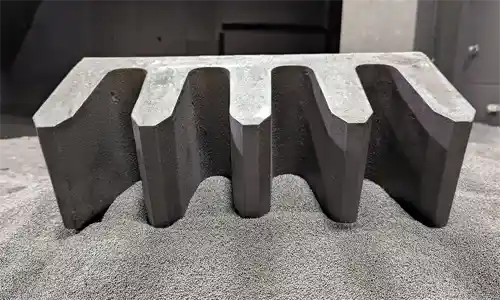Carbidic Austempered Ductile Iron
on October 20, 2025

General Overview of Carbidic Austempered Ductile Iron (CADI)
Carbidic austempered ductile iron (CADI) has an identical microstructure to austempered ductile iron (ADI), but with the addition of dispersed carbides which form during solidification. The combination of the carbides and the ausferrite matrix provides toughness and wear resistance. CADI is more wear resistant than ADI. It is not as wear resistant as high chrome white iron.
Read: To understand why high chrome white iron is so abrasion resistant, read this.
CADI can be produced with specific applications in mind. More carbides will limit the toughness, but increase wear resistance. A less carbidic structure may give less wear resistance, but more toughness. Carbides can be promoted through strategic chills during the casting process. External carbides can be introduced through cast-in inserts, or as a welding/cladding process.
Note: Some studies have shown that the addition of carbides increases the abrasion resistance up to ~200% compared to conventional austempered ductile iron (although impact toughness did decrease compared to conventional ADI).1
Read: To take a quick look at a chart comparing several alloys like chrome white iron and austempered ductile iron, read “Alloy Comparison Chart Including Chrome White Iron”.
Composition of CADI
The goal while producing CADI is to control microstructure and reach optimum properties for the given application.
Suggested Chemical Aim: ASTM A897 Grade 2 150-110-07
Pro Tip: Consider decreasing graphitizing elements in ductile iron (like Si) thereby promoting growth of carbides during solidification. Additionally, you can increase alloying elements (like Cr, Mo, Ti) which stabilize carbides.2
Physical and Mechanical Properties
Since there is no standard for CADI it is important that desired physical and mechanical properties are discussed ahead of time.
Carbidic austempered ductile iron is often defined through microstructure, hardness, and wear properties.
Impact Properties
Unnotched Charpy of CADI @ 72F = 10 ft-lbs.3
Carbidic Austempered Ductile Iron (CADI) Design Tips
Consider the following when designing with CADI:
- Limited machinability
- Additional cost - There can be additional costs during production to ensure the carbides form
- More wear resistant than conventional ADI
- More toughness than tool steels and ceramics
Pro Tip: Try CADI as a potential replacement for manganese steel at equal or lower cost.
Applications
Agricultural Applications
- Rivers
- Teeth
- Plow points
- Wear plates
- Picker and baler components
- Extruder screws
Railroad Applications
- Contact suspension components
- Railcar wear plates
Construction and Mining Applications
- Digger Teeth
- Cutters
- Mill hammers
- Flails
- Guards
- Covers
Read: To learn more about austempered ductile iron, check out our austempered ductile iron webpage.
References
[1] S. Laino, J. Sikora, and R. C. Dommarco, “Wear Behavior of CADI Operating Under Different Tribosystems,” 2010
[2] S. Laino, J. Sikora, and R. C. Dommarco, “Influence of Chemical Composition and Solidifaction Rate on the Abraison and Impact Properties of CADI,” 2009
[3] J.R. Keough, and K.L. Hayrynen, “Carbidic Austempered Ductile Iron (CADI),” 2000

